The British Museum, the world’s oldest national public museum, has come under mounting pressure following the theft of more than 2,000 items earlier this month.
With police investigations under way, George Osborne, the chair of the British Museum, said more could have been done to prevent the thefts, which resulted in the resignation of the museum’s director Hartwig Fischer.
While some items have subsequently been recovered, the thefts have raised questions about the safeguarding of objects at the museum and reignited discussions about the repatriation and restitution of objects housed there.
A spokesperson from the museum said, “The British Museum fully acknowledges the complex histories of objects within the collection and recognises our responsibility to engage audiences about their interconnected history in the modern world.”
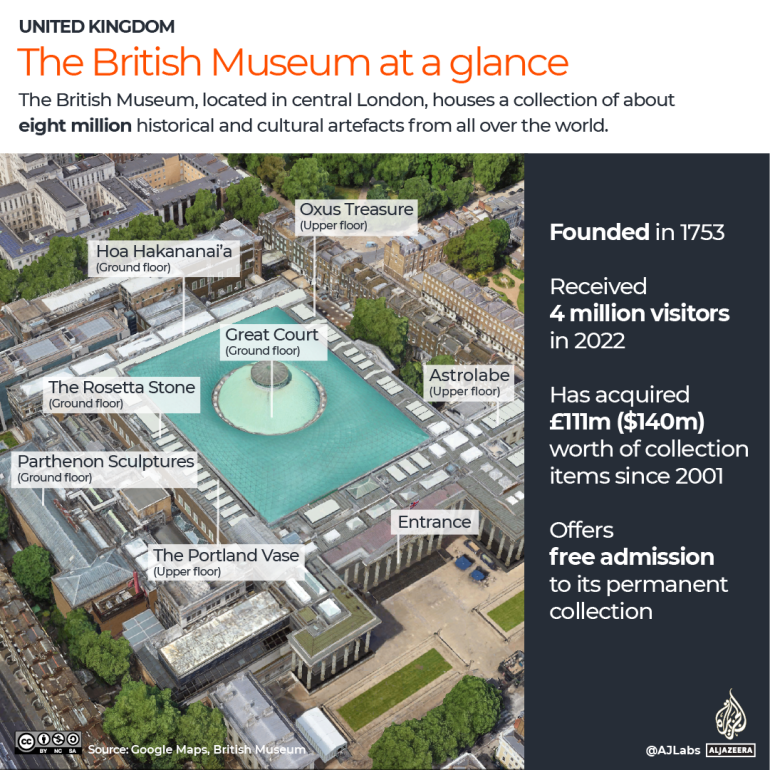
Founded in 1753, the museum first opened its doors in 1759. Located in central London, the British Museum, one of the city’s most popular tourist attractions with four million visitors in 2022, offers free admission to its permanent collection.
The British Museum received £47.8 million ($61m) in revenue and a £20 million ($25m) capital grant in aid from the governmental Department for Digital, Culture, Media and Sport during the 2022/23 financial year.
Since 2001, the museum has acquired £111m ($140m) worth of collection items, according to its annual report [PDF].
What is in the museum?
The British Museum has admitted that it does not have complete records of the estimated eight million items in its collection.
The oldest item is the Olduvai stone chopping tool, which is some 1.8 million years old, found in an early campsite in Tanzania.
The British Museum has long recognised that some of the items it houses are contested – a reminder of Britain’s colonial exploits. Below are some of the museum’s most famous items.
Rosetta Stone
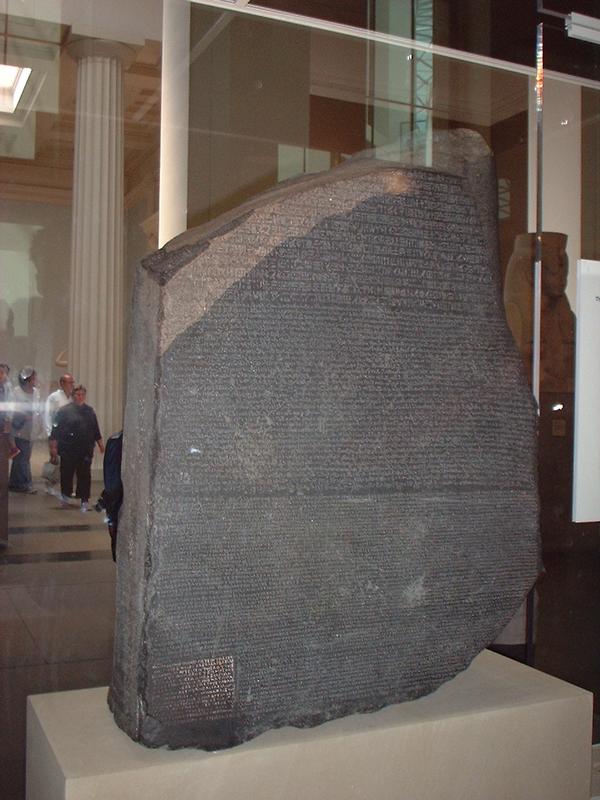
Origin: Egypt
One of the most famous items at the British Museum is the Rosetta Stone. Part of a bigger slab, the stone has carved into it a decree in three different writings – Hieroglyphics (14 lines), Demotic-Egyptian script (32 lines) and Ancient Greek (54 lines).
The stone was found accidentally by soldiers in Napoleon’s army, who were campaigning in Egypt from 1798 to 1801. Following Napoleon’s defeat, the stone was shipped to England in 1802.
Officials from Egypt have been requesting the stone be given back to its country of origin ever since.
The Parthenon Sculptures
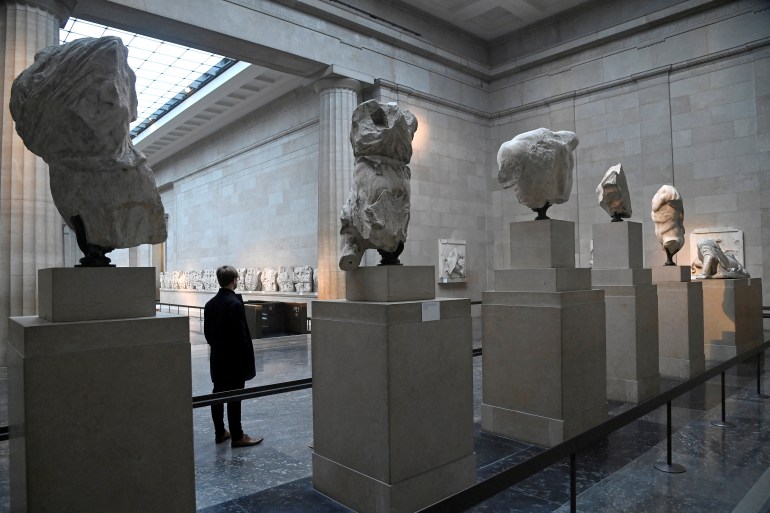
Origin: Greece
Also known as the Elgin Marbles, the Parthenon Sculptures are part of a frieze from Ancient Greece that adorned the temple of Athena on the Acropolis in Athens. The 17 sculptures and 15 metopes of the original frieze in the British Museum were made between 447 BC and 423 BC.
They were removed by Thomas Bruce, 7th Earl of Elgin, when Greece was under the rule of the Ottoman Empire. Greece first made a formal request for the permanent return of all of the sculptures in the museum’s collection in 1983.
Osborne, the museum’s chair, held talks with Greek Prime Minister Kyriakos Mitsotakis to loan some of the sculptures to Greece in exchange for Greek artefacts.
Benin Bronzes
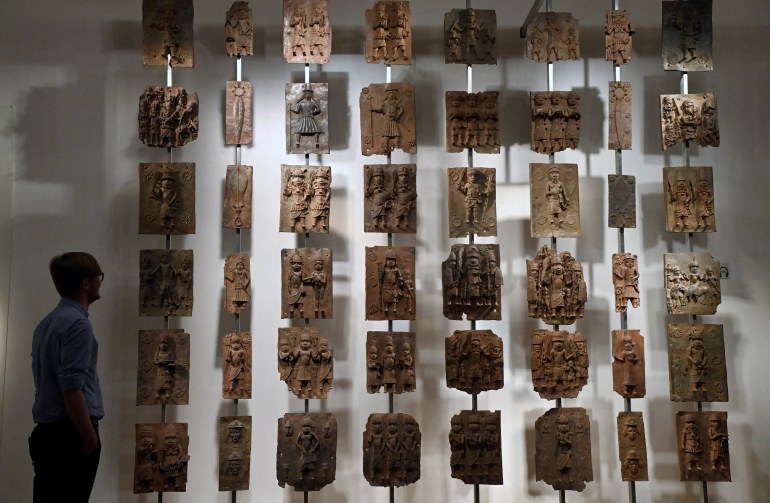
Origin: Benin City
The Benin Bronzes are a series of cast plaques and sculptures which decorated the royal palace of the Kingdom of Benin, the present-day capital of Edo State in Nigeria. The bronzes were made from at least the 16th century by expert craftsmen.
Benin City became part of the British Empire in 1897 until 1960. Following the British forces’ capture of Benin City, British forces looted many of the monuments and palaces. Some were given to Queen Victoria and others were sold privately or ended up in museums around the world.
Representatives of the Benin Royal Palace have made statements asking for the return of the bronzes and the Nigerian Federal Ministry of Information and Culture also asked the British Museum to return items in 2021.
The Portland Vase
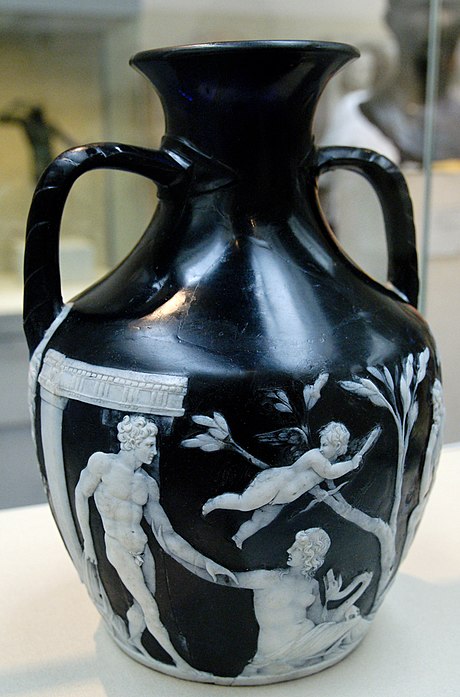
Origin: Italy
The Portland Vase is a two-handled glass amphora believed to date back to the first century during the reign of the Roman Emperor Augustus. The violet-blue glass vase features seven figures, a snake, and two bearded and horned heads.
The vase was part of the Barberini family collection. In 1790, the British ambassador in Naples purchased the vase and it was then sold to the Duchess of Portland. It has been at the British Museum since 1810 and was purchased by the museum in 1945.
Lamassu
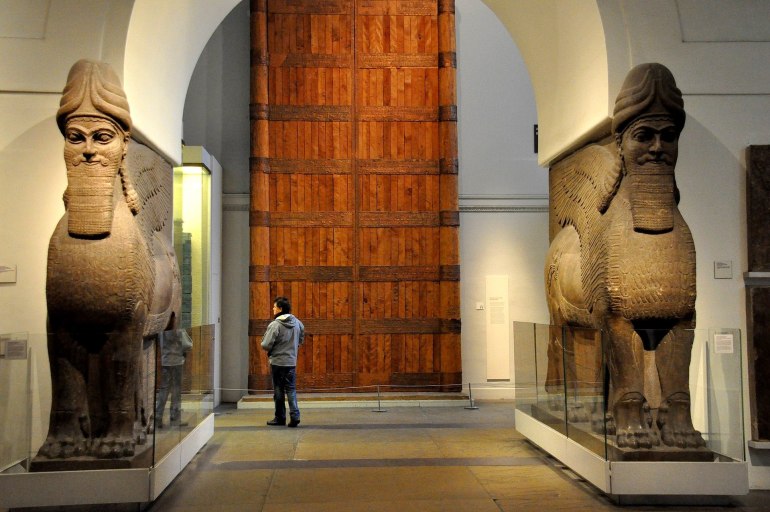
Origin: Iraq
The gypsum statue of a human-headed winged lion is said to have flanked the doorway of the throne room of the North West palace of Ashurnasirpal, the neo-Assyrian king, in Nimrud, an ancient city located in Iraq, 30km south of the city of Mosul.
It is thought to date back to 865 BC to 860 BC. It was excavated by Austen Henry Layard and acquired by the museum in 1851.
In recent years, the British Museum has repatriated pieces illegally taken from Iraq during the 2003 invasion, which were discovered by authorities in the UK.
Hoa Hakananai’a and Moai Hava

Origin: Rapa Nui
The museum is home to two moai from Rapa Nui (Easter Island) in eastern Polynesia. The Moai are megalithic statues, carved from basalt dating back to 1000-1200. They were placed on ceremonial platforms and are described as the living faces of the ancestors.
The statues ended up in the British Museum by way of a British survey ship, which was led to the location of the Moai Hava. The crew collected the first moai in1868 and unearthed a second. They were brought to Britain, with one being offered to Queen Victoria and the other donated to the British Museum.
In July 2019 a request for the return of Hoa Hakananai’a and Moai Hava was made on behalf of Rapa Nui.
Amaravati Marbles
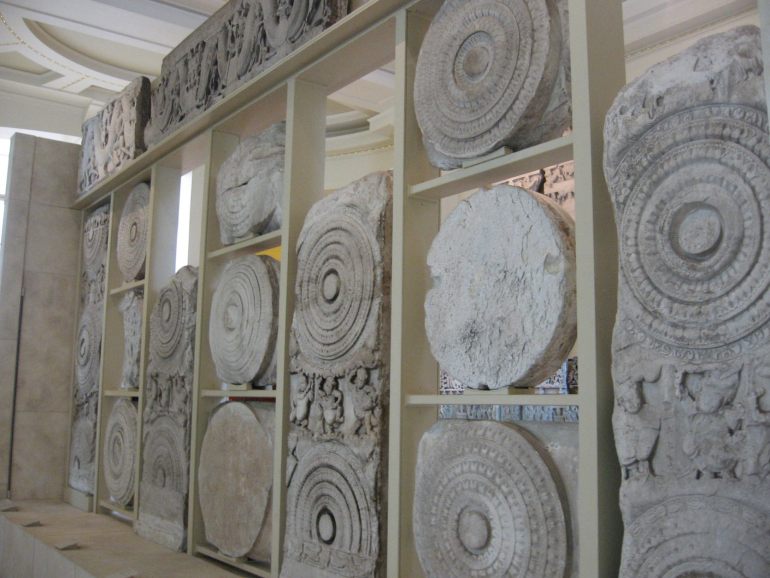
Origin: India
The collection of 120 sculptures made of limestone known as Palnad marble was recovered from the Amaravati Stupa in Andhra Pradesh, southeast India. The Great Shrine of Amaravati was founded in about 200 BC – believed to be one of the oldest Buddhist monuments in India.
The marbles came to England following their excavation in 1816-17 by a British survey team, with more than 120 being shipped to the British Museum.
The Admonitions of the Instructress to the Court Ladies
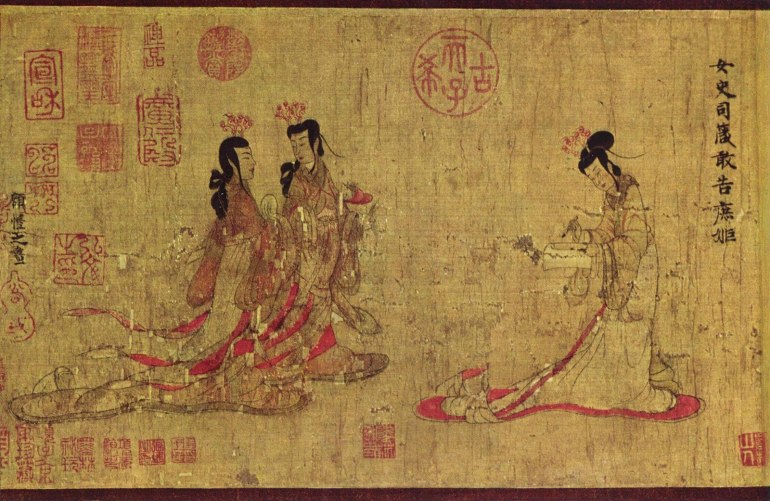
Origin: China
The Admonitions of the Instructress to the Court Ladies is a scroll dating between AD 400 to 700. It is usually only displayed for six weeks a year, due to conservation precautions. The scroll depicts a poetic narrative painting on silk by the poet Zhang Hua.
The scroll was purchased by the British Museum from Captain Clarence Johnson who was in Beijing in 1900 during the Boxer Rebellion.
Chinese state media recently called for the British Museum to return Chinese artefacts following the recent theft at the museum.
Mokomokai
Origin: New Zealand
Toi moko are preserved Maori heads. The preservation of heads in Maori culture is done to honour the dead person. Currently, the British Museum has seven preserved, tattooed heads of Maori people in its archives. New Zealand has asked for the restitution of the Toi moko.
More than 6,000 human remains are in the care of the British Museum. Since 1997, the museum has received eight claims on human remains at the museum.
Oxus Treasure
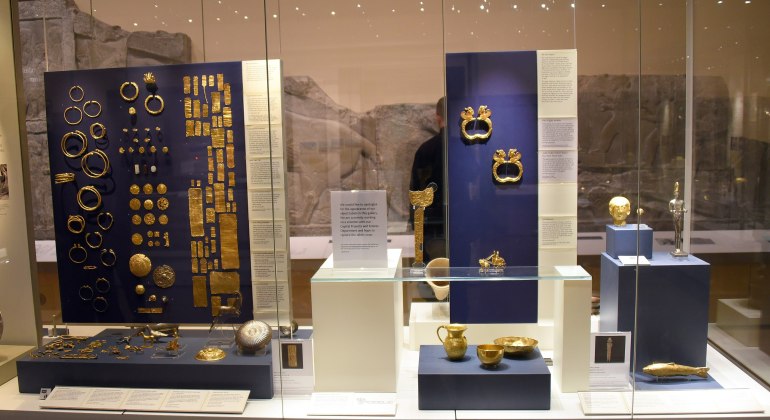
Origin: Tajikistan
The Oxus Treasure dates back to the Achaemenid Empire in the 5th to 3rd century BC and is a collection of 180 pieces of gold and silver found in the Oxus river. They were discovered near the town of Takht-i Sangin in Tajikistan between 1876-1880. The collection at the British Museum features armlets, a gold chariot and other statuettes.
Where do the items come from?
According to the museum’s online search guide, the British Museum has been working on expanding its database for at least 40 years and, even with more than two million records, it has only catalogued “about half of the collection”.
It goes on to mention that “in many cases, the most recent research has not yet been added. There will be mistakes and omissions, but the Museum chooses to publish the data, rather than hold it until it is finished”.
In April 2020, the museum launched a major revamp of its online collection. According to its press release, 4.5 million objects and 1.9 million images were made available to the public.
You can browse 4.5m objects and 1.9m images, and there are lots of new updates – you can now zoom in and pan over images, revealing more detail than ever before.
Try it out on the Game of Ur here: https://t.co/FfgVAMkGnv #MuseumFromHome pic.twitter.com/Wk6DqIketr
— British Museum (@britishmuseum) April 28, 2020
The museum’s press office told Al Jazeera that the digitisation process would be completed as soon as possible.
An analysis by Al Jazeera of the British Museum’s online database, as of August 30, found that 2.2 million items from at least 212 different countries around the world had been catalogued.
At least 649,727 items were categorised as being made in, acquired or found in the United Kingdom, with most – 625,371 – from England.
Outside of the UK, the museum database returned 164,140 results from Iraq, followed by Italy (147,697), Egypt (119,854), France (81,980), Turkey (73,922), Germany (66,273), Greece (64,928), China (58,749) and India (52,518).
The table below provides a country by county breakdown of the museum’s catalogued collection. Use the search feature to find your country.
"come" - Google News
August 31, 2023 at 07:47PM
https://ift.tt/yfTquKW
Where do the items in the British Museum come from? - Al Jazeera English
"come" - Google News
https://ift.tt/nzjFdup
Shoes Man Tutorial
Pos News Update
Meme Update
Korean Entertainment News
Japan News Update
Bagikan Berita Ini














0 Response to "Where do the items in the British Museum come from? - Al Jazeera English"
Post a Comment